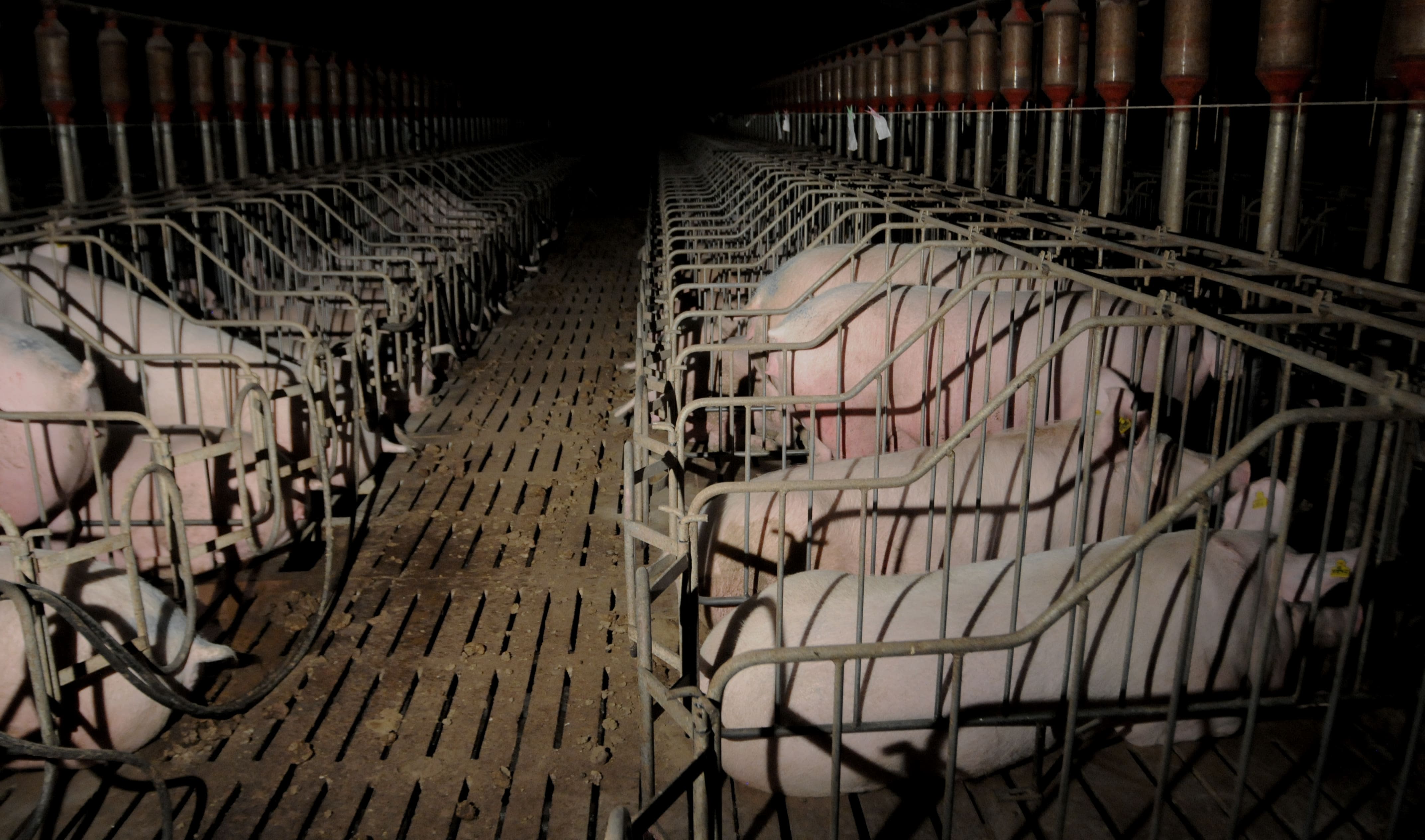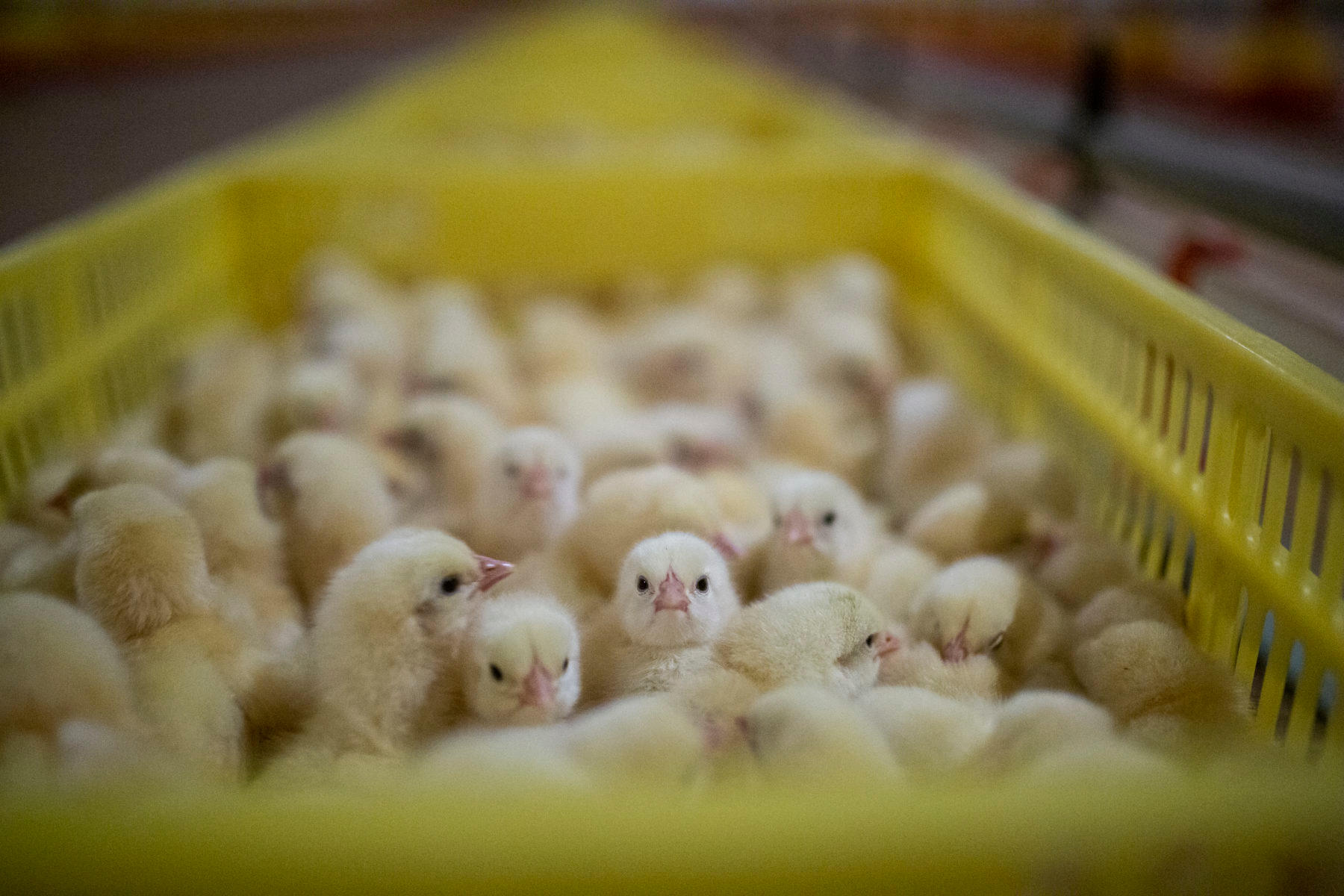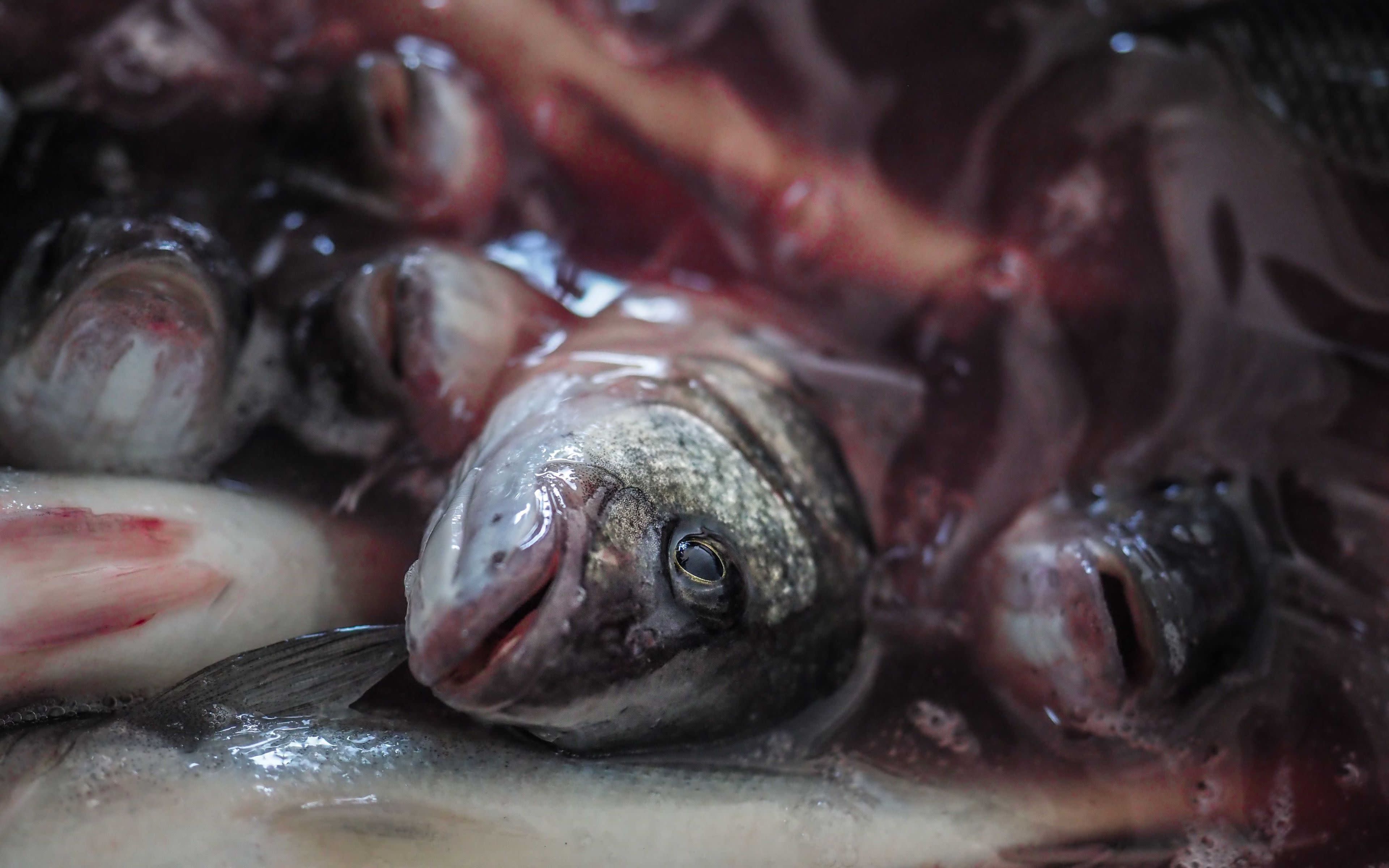




Over the last century, the once pastoral farmlands of America have undergone a tremendous transformation, and not for the better.

What do you think of when the word “agriculture” comes to mind? If you’re like many people, you’ll imagine fields of green sprinkled with lush rows of vegetables, and a red-painted barn with pigs, cows, and chickens leisurely roaming in and out of the open front door.
There is a reason why these images may be summoned to mind. Afterall, this is how agriculture once looked. But over the last century, the once pastoral farmlands of America have undergone a tremendous transformation, and not for the better.
What Is Intensive Agriculture?
Intensive agriculture aims to produce the greatest outputs—usually in the form of profits—while spending the fewest resources. When it comes to animal agriculture, where animals are farmed for meat, milk, eggs, or other products, intensive agriculture is synonymous with factory farms, or, as they are more politely called by the government and the animal agriculture industry, concentrated animal feeding operations (CAFOs). Simply put, CAFOS are torture chambers for animals. Continue reading to find out why.
Extensive vs. Intensive Agriculture
Extensive agriculture means farming at smaller scales, with less mechanization. Remember that red-painted barn we envisioned earlier? That’s a form of extensive agriculture, where a farmer and their small team cares for a relatively small number of animals. Often these places are family-run. Cows might be milked by hand or eggs might be collected from the hen houses and dropped into baskets. There are many different forms of extensive agriculture, including nomadic herding, where people roam vast distances along with herds of cows or goats, spending days and nights beneath the skies. The problem is, extensive farming is far from the norm.
Intensive agriculture is, in many ways, the opposite of extensive farming. It’s also how 99% of all animals are raised for food in the US—meaning that intensive agriculture, not extensive agriculture, is the means by which nearly all of our food makes its way to our plates. Factory farms are capable of holding thousands of animals captive in one barn or shed, often within cages their whole lives. Teams of workers tend to these animals, but at times, due to the sheer number of animals, one worker can be responsible for hundreds of animals—making it nearly impossible to deliver the care that each animal needs and deserves. Because these factory farms are just that, factories, their focus is on maximizing profits by cutting costs. As such, machines are also employed whenever possible to keep animals alive. Not healthy. Just alive.
Both animals and people bear the burden of these cost-saving measures.
Examples of Intensive Agriculture
You may not have seen a factory farm before, or if you have, it may not be obvious to the eye. Instead, you may see what looks like rows of enormous garages or storage sheds—often windowless and blank on the outside. But taking a look inside a factory farm will put your appetite to the test.
Livestock
“Livestock” is an agriculture-industry term, referring to certain species of farm animals that produce “red meat,” such as sheep, cattle, and pigs. However, fish and birds are excluded from the United States Department of Agriculture (USDA) definition.
Cows and pigs, alongside all animals raised for meat in factory farms, are forced to endure the torturous conditions of intensive agriculture. Pregnant pigs, known as sows, are forcibly impregnated in order to pump out piglets who are raised and killed to become bacon, ham, sausage, and other pork products. (None of these products, you may observe, are named by what they actually are—pigs.) Throughout their pregnancies, sows are confined to gestation crates, cages that are not much bigger than their own bodies. Prevented from walking, running, or even being able to turn around, these pigs slowly go mad with boredom, frustration, and endless despair.
Dairy cows also face the horrors of factory farms. These gentle, emotional beings are often tethered to one stall for the majority of their lives, prevented from doing anything that might come naturally, besides eating and defecating. Even when cows aren’t tethered, it is common practice to keep them inside filthy barns their whole lives, crammed together with nowhere to go and no hope for a better life. Time and time again, they are impregnated, which forces their battered bodies to naturally produce milk. And time and time again their newborn infants are ripped away from them forever, to be shot or sent to live alone in a veal crate where they languish without their mother, before being killed at a few months old for their prized young meat.
But the horrors of intensive farming don’t stop there.
Aquaculture
Aquaculture, a term used to represent the raising of marine life for food or other purposes, includes animals such as fish and shellfish. The most damaging form of aquaculture is fish farms. Whether these farms are based on land (as they sometimes are), or in lakes, rivers, or offshore in the ocean, they are notorious for polluting the local habitat with fish feces. Fish farms force hundreds or thousands of fish together, where they swim in endless circles as they are doused with drugs to keep them alive. Diseases like sea lice, that easily breed in these cramped environments, slowly, and painfully eat fish alive. For species like salmon, who are accustomed to making great migrations, they simply cannot carry out their natural travels. Needless to say, this disrupts every sense of normality they would have in the wild. It’s no surprise that the impoverished conditions on fish farms can lead to serious depression in fish.
And don’t let anyone tell you farmed fish is better than wild-caught fish, since farmed fish often require huge numbers of wild fish to be caught in order to feed them.
There’s simply nothing good about fish farms.
Crops
Ecosystems are intricately complex communities, filled with an abundance and diversity of life that exist together in an interdependent web. Intensive agriculture changes all that. Often, natural places, life forests or meadows, are cleared to provide space for monocrops. As the name indicates, monocrops are vast fields of the same type of plant—row after row. Corn, soy, and wheat are a few of the plants that make up monocrops—grains that are often used to feed animals raised for food. Monocropping usually requires enormous amounts of pesticides and fungicides to keep plants alive, since they are not supported by the essential biodiversity that helps crops better withstand attacks from insects and pests, eliminating the need for pesticides in the first place. Artificial fertilizers are also needed since monocropping depletes the soil of its natural life-giving nutrients.
Why Is Intensive Farming Bad?
Intensive farming is not only bad, it is an atrocity—and one that produces nearly all the food people consume in places like the United States.
Animal Cruelty
The defining characteristic of intensive animal farming is cruelty. Animals are treated so poorly that there is simply no question that the architects of this food system did not truly consider the natural needs and well-being of animals when designing it.
Farmed animals are welcomed into the world with violent mutilations, without painkillers. Portions of the beaks of chickens, ducks, and turkeys are sliced off, and some have parts of their toes removed as well. Male cows and pigs can be castrated. The tails of pigs and cows can be chopped off, while their ears are pierced with identifying tags. They are given only numbers. Never names.
After this jarring and unimaginably painful start to their lives, they are trucked to factory farms where they will spend most of their short, brutal lives. Within the closed doors of these “farms,” they can never wander off for a moment of privacy, feel the sun on their backs, or play with their friends. Birds, like chickens, are prevented from ever taking to the skies, or often even fully stretching their wings, while livestock animals will never get to root around in the earth with their noses and hooves. Instead, all they will ever know is a darkened, cramped existence where they are left no choice but to live and lie down in their own feces. This is their life, until their final trip—to the slaughterhouse.
In the US, federal welfare laws mandate that farmed animals must be killed in ways that are as painless as possible (but, bafflingly, this law excludes the billions of chickens, turkeys, and other birds who are killed each year). Even these protections, afforded to some animals, don’t shield them from gory, horrible deaths. Animals such as cattle and pigs are supposed to be rendered unconscious before they are hung upside down, their throats slit to drain their life’s blood, before they are dismembered with chainsaw-like equipment. But because farming corporations want to make as much money as possible, they force workers to rush the killing process, resulting in many instances of improper stunning. Animals are sometimes still alive and kicking as their bodies are ripped apart.
Deforestation
Intensive agriculture results in many serious environmental problems, but one of the worst is deforestation. In the Amazon rainforest, home to Indigenous people and critical habitat for regulating the world’s weather patterns, huge swaths of forest are cleared for animal agriculture every day. Trees are felled to create pastureland for cattle or to create huge fields of mono crops that feed animals held prisoner in CAFOs (factory farms). Intensive agriculture, and the demand for meat and animal products, are driving one of the biggest environmental catastrophes today.
Risks On Human Health
Intensive agriculture impacts people, too, in ways that can be fatal. Farmworkers exposed to the toxic environments of factory farms are at high risk of developing diseases like colon cancer, melanoma, non-Hodgkin lymphoma, and other conditions. The heavy use of pesticides and artificial fertilizers on crops can lead to birth defects for those who are exposed directly or living in the surrounding area. And hormones, used in dairy operations to make cows produce more milk, can wind up in human systems. Studies have linked recombinant bovine somatotropin (RBS) to elevated risks of breast cancer.
What Can You Do to Help?
Before despair sets in, know that there is hope. And that hope is you! Every meal, every day, you get to choose what you support, and what you don’t. Eating a plant-based diet—especially when the focus is on local, whole foods—shifts money and power away from big animal agriculture toward farmers and food manufacturers who support a regenerative economy and world. Isn’t that a world you want to be a part of?
Beyond leaving animals off your plate, you can also let some of the world’s largest corporations know that it’s time to change—for the animals and for our planet. The time is now, before it’s too late.






